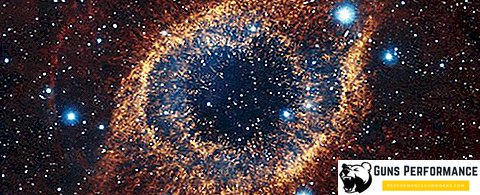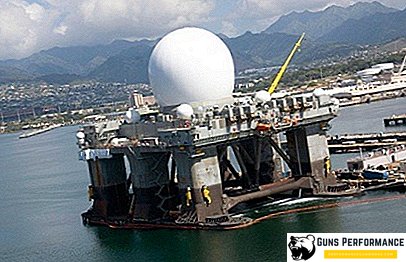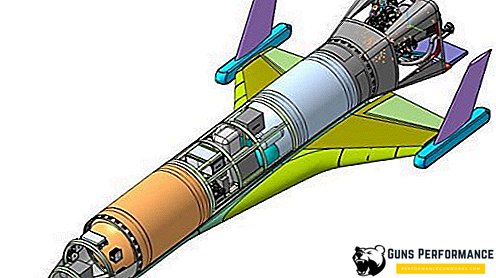Since the birth of the universe, more than ten billion years have passed, during which stellar evolution occurs, changes in the composition of outer space take place. Some space objects disappear, and others appear in their place. This process happens all the time, however, due to the huge time intervals, we are able to watch only one single frame of the colossal and fascinating multisession.

We see the Universe in all its glory, observing the life of stars, the stages of evolution and the moment of death agony. The death of a star is always a grand and vivid event. The larger and more massive the star, the larger the cataclysm.
The neutron star is a vivid example of such an evolution, a living monument to the former star power. This is the whole paradox. In place of a massive star, the dimensions and mass of which are tens and hundreds of times higher than those of our Sun, a tiny celestial body with a diameter of a few tens of kilometers emerges. Such a transformation does not occur at one moment. The formation of neutron stars is the result of a long evolutionary path of development of a cosmic monster stretched in space and in time.

Neutron star physics
Such objects are few in the Universe, as it may seem at first glance. As a rule, a neutron star can be one per thousand stars. The secret of such a small number lies in the uniqueness of the evolutionary processes that precede the birth of neutron stars. All stars live their lives differently. The star drama finale looks different too. The scale of the action is determined by the mass of the star. The greater the mass of the cosmic body, the more massive the star, the higher the likelihood that its death will be fast and bright.

Constantly increasing gravitational forces lead to the transformation of stellar matter into thermal energy. This process is unwittingly accompanied by a colossal release - the Supernova explosion. The result of such a cataclysm is a new space object - a neutron star.
Simply put, stellar matter ceases to be a fuel, thermonuclear reactions lose their intensity and are not able to maintain necessary temperatures in the depths of a massive body. The collapse becomes the exit from the created state - the collapse of the stellar gas on the central part of the star.
All this leads to an instantaneous release of energy, scattering the outer layers of stellar matter in all directions. In place of a star, an expanding nebula appears. Such a transformation can occur with any star, but the results of the collapse may be different.
If the mass of a space object is small, for example, we are dealing with a yellow dwarf like the Sun, a white dwarf remains in place of the flash. In the event that the mass of the cosmic monster exceeds the solar mass dozens of times, as a result of the collapse we observe a Supernova explosion. In place of the former stellar majesty a neutron star is formed. Supermassive stars, whose mass is hundreds of times greater than the mass of the Sun, complete their life cycle, the neutron star is an intermediate stage. Continuing gravitational compression leads to the fact that the life of a neutron star ends with the appearance of a black hole.

As a result of the collapse of the star, only the core remains, continuing to shrink. In this regard, a characteristic feature of neutron stars are high density and huge mass with meager sizes. So the mass of a neutron star with a diameter of 20 km. 1.5-3 times the mass of our star. The compaction or neutronization of electrons and protons into neutrons occurs. Accordingly, with a decrease in volume and size, the density and mass of stellar matter rapidly increase.
Composition of neutron stars
Accurate information on the composition of neutron stars is not available. Today, astrophysicists use the working model proposed by nuclear physicists to study such objects.

Presumably, the stellar substance is transformed into a neutron, superfluid liquid as a result of collapse. This is facilitated by a huge gravitational attraction, which exerts constant pressure on the substance. Such a "nuclear liquid substance" is called a degenerate gas and 1000 times denser than water. The atoms of a degenerate gas consist of a nucleus and electrons revolving around it. With neutronization, the internal space of atoms disappears under the influence of gravitational forces. The electrons merge with the nucleus, forming neutrons. The stability of superdense substance gives the internal gravity. Otherwise, a chain reaction would inevitably begin, accompanied by a nuclear explosion.

The closer to the outer edge of the star, the lower the temperature and pressure. As a result of complex processes, the "cooling" of the neutron substance occurs, from which the iron nuclei are intensively released. Collapse and subsequent explosion is a factory of planetary iron, which is distributed in outer space, becoming a building material during the formation of planets.
It is the outbreak of supernovae that the Earth owes to the fact that cosmic iron particles are present in its structure and structure.
Conditionally considering the structure of a neutron star in a microscope, we can distinguish five layers in the structure of an object:
- the atmosphere of the object;
- outer bark;
- inner layers;
- outer core;
- inner core of a neutron star.
The atmosphere of a neutron star is only a few centimeters thick and is the thinnest layer. According to its composition, it is a plasma layer responsible for the thermal irradiation of a star. Next comes the outer bark, which is several hundred meters thick. Between the outer crust and the inner layers is the realm of a degenerate electron gas. The deeper to the center of the star, the faster this gas becomes relativistic. In other words, the processes occurring inside a star are associated with a decrease in the fraction of atomic nuclei. The number of free neutrons increases. The inner regions of a neutron star represent the outer core, where neutrons continue to coexist with electrons and protons. The thickness of this layer of substance is several kilometers, while the density of matter is ten times higher than the density of the atomic nucleus.

All this atomic soup exists due to the colossal temperatures. At the time of the Supernova explosion, the temperature of the neutron star is 1011K. During this period, a new celestial object has the maximum luminosity. Immediately after the explosion, a stage of rapid cooling sets in, the temperature drops to a level of 109K within a few minutes. Subsequently, the cooling process slows down. Although the temperature of the star is still high, the luminosity of the object decreases. The star continues to glow only due to thermal and infrared radiation.
Neutron Star Classification
Such a specific composition of the stellar-nuclear substance causes a high nuclear density of a neutron star of 1014-1015 g / cm ³, while the average size of the resulting object is not less than 10 and not more than 20 km. A further increase in density is stabilized by neutron interaction forces. In other words, the degenerate stellar gas is in a state of equilibrium, keeping the star from the next collapse.

The rather complex nature of such space objects as neutron stars became the reason for the subsequent classification, which explains their behavior and existence in the vast Universe. The main parameters on the basis of which the classification is carried out are the period of rotation of the star and the scale of the magnetic field. In the course of its existence, the neutron star loses its rotational energy, and the magnetic field of the object decreases. Accordingly, the celestial body passes from one state to another, among which the most characteristic are the following types:
- Radio pulsars (ejectors) are objects that have a short period of rotation, but the magnetic field strength remains fairly large. Charged particles, making a movement along the force fields, leave the star's shell in the cliffs. The celestial body of this type ejects, periodically filling the Universe with radio pulses fixed in the radio frequency range;
- Neutron star - propeller. In this case, the object has an extremely low speed of rotation, however, the magnetic field does not have sufficient force to attract elements of matter from the surrounding space. The star does not radiate pulses, accretion does not occur in this case (the fall of cosmic matter);
- X-ray pulsar (accretor). Such objects have a low speed of rotation, but due to the strong magnetic field, the star intensively absorbs material from outer space. As a result, in places where stellar matter falls on the surface of a neutron star, plasma is accumulated, heated to millions of degrees. These points on the surface of a celestial body become sources of pulsating thermal, X-ray radiation. With the advent of powerful radio telescopes capable of looking into the depths of space in the infrared and X-ray range, it became possible to quickly detect quite a lot of conventional X-ray pulsars;
- A geotator is an object that has a low rotational speed, while stellar matter accumulates on the star's surface as a result of accretion. A strong magnetic field prevents the formation of plasma in the surface layer, and the star gradually gains its mass.


As can be seen from the existing classification, each of the neutron stars behaves differently. From this various methods of their discovery follow, and it is possible that the fate of these celestial bodies will be different in the future.
Paradoxes of neutron star birth
The first version that neutron stars are the products of the Supernova explosion is not a postulate today. There is a theory that another mechanism can be used here. In double star systems, white dwarfs become food for new stars. Stellar matter gradually flows from one space object to another, increasing its mass to a critical state. In other words, in the future, one of the white dwarf pair is a neutron star.

Often, a single neutron star, being in the close environment of star clusters, turns its attention to the nearest neighbor. Companions of neutron stars can be any stars. These pairs occur quite often. The consequences of such a friendship depend on the mass of the companion. If the mass of the new companion is small, then the stolen stellar matter will accumulate around in the form of an accretion disk. This process, accompanied by a large period of rotation, will lead to the fact that stellar gas will warm up to a temperature of a million degrees. The neutron star will flare up with an X-ray flux, becoming an X-ray pulsar. This process has two ways:
- the star remains in space a dull celestial body;
- the body begins to emit short x-ray flashes (bursters).
During X-ray flashes, the brightness of the star rapidly increases, making such an object 100 thousand times brighter than the Sun.

The history of the study of neutron stars
Neutron stars became the discovery of the second half of the 20th century. Previously, it was technically impossible to detect such objects in our galaxy and in the Universe. The dim light and small size of such celestial bodies did not allow them to be detected using optical telescopes. Despite the lack of visual contact, the existence of such objects in space was predicted theoretically. The first version of the existence of stars with a huge density appeared with the filing of the Soviet scientist L. Landau in 1932.

A year later, in 1933, already over the ocean, a serious statement was made about the existence of stars with an unusual structure. Astronomers Fritz Zwicky and Walter Baade put forward a well-grounded theory that a neutron star always remains in place of the Supernova explosion.
In the 1960s, a breakthrough in astronomical observations became apparent. This was facilitated by the appearance of X-ray telescopes capable of detecting sources of soft X-ray radiation in space. Using the theory of the existence in space of sources of strong thermal radiation, astronomers have concluded that we are dealing with a new type of stars. A significant addition to the theory of the existence of neutron stars was the discovery in 1967 of pulsars. The American Jocelyn Bell, using his radio equipment, detected radio signals coming from space. The source of radio waves was a rapidly rotating object that acted like a radio beacon, sending signals in all directions.

Such an object certainly has a high rotational speed, which would be fatal for an ordinary star. The first pulsar, which was discovered by astronomers, is PSR В1919 + 21, located at a distance of 2283.12 sv. years from our planet. According to scientists, the closest neutron star to Earth is the space object RX J1856.5-3754, located in the constellation South Corona, which was opened in 1992 at the Chandra observatory. The distance from the Earth to the nearest neutron star is 400 light years.












